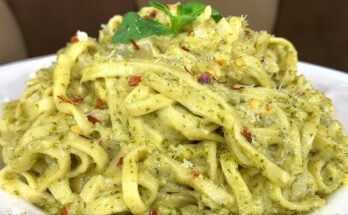Chicken Fricassee Recipe: Chicken fricassee is a timeless comfort dish, rich in flavor and heritage. Imagine tender chicken pieces stewed in a luscious, creamy white sauce—yes, that’s chicken fricassee! It’s not just a dish; it’s an experience. A fricassee is technically a cross between a sauté and a stew. The chicken is browned, then simmered gently with vegetables in a white sauce that’s usually enriched with cream or a touch of wine.
This dish has won hearts across the world for its soul-soothing flavor and simple elegance. Whether you’re planning a cozy dinner at home or looking to impress guests, chicken fricassee is a sure winner. The best part? It’s flexible enough for you to make it your own.
Origins and Culinary Heritage
Rooted deeply in French cuisine, the word “fricassee” comes from the French term “fricassée,” meaning to fry and stew. While it’s a staple in French kitchens, chicken fricassee has traveled far and wide, with each region adding its own twist. Some use mushrooms, others go for a tomato base, while Caribbean versions might even feature coconut milk.
This recipe brings you a classic version that captures the essence of traditional French cooking, but you’ll find room to tweak and personalize it based on what you love or have in your pantry.
Ingredients Needed
For the Chicken:
- 2½ to 3 lbs bone-in, skin-on chicken (legs and thighs preferred)
- Salt and pepper to taste
- 2 tbsp olive oil
- 1 tbsp unsalted butter
For the Sauce:
- 1 medium onion, finely chopped
- 2 garlic cloves, minced
- 2 carrots, peeled and diced
- 2 celery stalks, diced
- 1 cup mushrooms, sliced
- 2 tbsp all-purpose flour
- 1 cup dry white wine (optional but recommended)
- 2 cups chicken broth
- ½ cup heavy cream
- 1 bay leaf
- 1 tsp fresh thyme leaves or ½ tsp dried thyme
Optional Add-ins:
- ½ cup frozen peas
- Fresh parsley for garnish
- A squeeze of lemon juice for brightness
Tools and Equipment
To get started, make sure you have the following kitchen tools handy:
- Large Dutch oven or deep skillet with lid
- Cutting board and sharp knife
- Wooden spoon or spatula
- Measuring cups and spoons
- Small whisk (for sauce)
The right tools make all the difference in ensuring even cooking and a smooth sauce.
Step-by-Step Cooking Instructions
Step 1: Prepare the Ingredients
Start by seasoning the chicken with salt and pepper on both sides. Dice the carrots, celery, onions, and mushrooms. Mince the garlic. This prep work sets the stage for smooth cooking later on. If you’re using wine, open the bottle and measure it out now. Trust me, once things start heating up, you’ll want everything within arm’s reach.
Step 2: Brown the Chicken
In a large Dutch oven, heat the olive oil and butter over medium-high heat. Place the chicken skin-side down and let it sear without moving it for 4–5 minutes. You want that golden-brown crust—it’s flavor gold! Flip the pieces and cook for another 4 minutes. Remove the chicken and set it aside. Don’t clean the pot; those brown bits at the bottom are packed with umami goodness.
Step 3: Sauté the Vegetables
Lower the heat to medium. In the same pot, add chopped onions, carrots, celery, and mushrooms. Sauté for 5–7 minutes until soft and fragrant. Add garlic and cook for 1 minute more. Sprinkle the flour over the vegetables and stir well for 2 minutes to eliminate the raw flour taste.
Step 4: Build the Sauce
Pour in the white wine and use a wooden spoon to scrape up any bits stuck to the bottom. Let the wine simmer for 3 minutes to cook off the alcohol. Slowly stir in the chicken broth, then add the thyme and bay leaf. Bring the sauce to a gentle boil—it should thicken slightly.
Return the chicken to the pot, skin-side up. Cover with a lid, reduce the heat, and let it simmer for 25–30 minutes until the chicken is cooked through and tender.
Step 5: Simmer to Perfection
Once the chicken is done, remove it again briefly. Stir in the cream and optional peas. Simmer uncovered for another 5–10 minutes to let the sauce thicken and flavors meld. Taste and adjust seasoning—maybe a touch more salt, a grind of pepper, or a splash of lemon juice.
Return the chicken to the sauce, garnish with parsley, and serve hot.
Tips for Best Flavor
If you want your chicken fricassee to taste like it came straight from a French countryside kitchen, here are some pro tips to bring your dish to life:
- Use bone-in, skin-on chicken: This type of chicken adds deeper flavor and keeps the meat juicy throughout the simmering process. The skin also crisps beautifully when seared.
- Don’t rush the browning process: Those golden bits (fond) left in the pan after browning the chicken are flavor bombs. They dissolve into the sauce, enriching it with depth and complexity.
- Choose quality stock: Whether homemade or store-bought, opt for low-sodium chicken stock so you can control the salt content. A rich, gelatinous broth adds silkiness to the sauce.
- Incorporate fresh herbs: Fresh thyme, bay leaf, and parsley all add aromatic layers. Toss them in while simmering and sprinkle fresh parsley just before serving.
- Deglaze properly: When you pour in the wine or broth, take the time to scrape up all the caramelized bits at the bottom of the pot. That’s pure savory gold.
Want even more flavor? Try roasting your vegetables for a smoky undertone or adding a splash of brandy before the wine.
Common Mistakes to Avoid
Even a simple dish like chicken fricassee can go sideways if you’re not careful. Here are some pitfalls to steer clear of:
- Overcrowding the pan: Searing chicken in a packed pan causes steaming instead of browning. Always brown in batches if needed.
- Skipping the flour step: The flour creates the base for your velvety sauce. If you forget it, your sauce might turn out watery instead of luxuriously thick.
- Using high heat while simmering: A rapid boil can toughen the chicken. Keep your pot at a gentle simmer so the meat stays tender and moist.
- Adding cream too early: Cream should be stirred in at the end to prevent curdling and preserve its smooth, rich texture.
- Not tasting as you go: Adjust seasoning at every stage. A splash of acidity (like lemon juice or vinegar) at the end brightens up the dish beautifully.
Avoid these traps, and you’ll have a dish that’s creamy, dreamy, and utterly delicious.
Variations of Chicken Fricassee
Chicken fricassee is like a canvas—you can paint it with any flavors you love. Here are some fun and tasty variations:
- Caribbean Chicken Fricassee: Add scotch bonnet pepper, thyme, scallions, and a splash of coconut milk for a tropical twist. Serve with rice and fried plantains.
- Italian-Style Fricassee: Replace cream with tomatoes and use rosemary instead of thyme. Add olives and capers for a Mediterranean punch.
- Mushroom Lover’s Fricassee: Go heavy on the mushrooms—think shiitake, cremini, or porcini. They add umami and depth.
- Vegan Fricassee: Sub in firm tofu or jackfruit and use plant-based cream. Mushrooms can take center stage for that hearty feel.
- Spicy Fricassee: Toss in some chili flakes or paprika for a kick. This goes especially well with crusty bread or rice.
Feel free to get creative. Fricassee adapts beautifully to different cuisines, pantry items, and preferences.
Serving Suggestions
What pairs well with chicken fricassee? Here are some delightful sides and plating ideas to elevate your meal:
- Mashed Potatoes: Creamy mashed potatoes soak up all that rich sauce. It’s a match made in comfort food heaven.
- White Rice or Pilaf: Fluffy rice balances the richness of the fricassee and provides a neutral base.
- Crusty Bread: You’ll want something to mop up every last drop of sauce. A warm baguette or sourdough works wonders.
- Roasted Vegetables: Add some color and texture with roasted Brussels sprouts, asparagus, or green beans.
- Fresh Green Salad: A light salad with a tangy vinaigrette cuts through the richness and freshens up the plate.
For drinks, white wines like Chardonnay or Sauvignon Blanc complement the creamy sauce, while a sparkling water with lemon offers a refreshing contrast.
Storage and Reheating
Got leftovers? Chicken fricassee is one of those dishes that tastes even better the next day. Here’s how to store and reheat it:
- Refrigeration: Allow the dish to cool completely, then transfer it to an airtight container. It will keep in the fridge for up to 4 days.
- Freezing: Freeze the cooled chicken and sauce in a freezer-safe container for up to 2 months. Note that cream sauces can sometimes separate when reheated, so stir gently when warming.
- Reheating: Warm gently on the stovetop over medium-low heat, stirring occasionally. If the sauce is too thick, add a splash of chicken broth or cream to loosen it up.
Avoid using the microwave if possible—it can overcook the chicken and ruin the sauce’s texture.
Nutritional Information
Here’s an approximate breakdown for one serving of chicken fricassee (based on 6 servings):
| Nutrient | Amount |
|---|---|
| Calories | 430 kcal |
| Protein | 32 g |
| Carbohydrates | 10 g |
| Fat | 28 g |
| Saturated Fat | 12 g |
| Fiber | 2 g |
| Sugar | 3 g |
| Sodium | 450 mg |
Keep in mind, nutritional values will vary based on the ingredients you use and your portion size.
FAQs about Chicken Fricassee Recipe
1. Can I use boneless chicken?
Absolutely! Boneless thighs or breasts work well, though they may cook faster. Keep an eye on them to avoid drying out.
2. What’s the best wine to use?
A dry white wine like Chardonnay or Sauvignon Blanc adds a nice depth. If you prefer to skip alcohol, just use more chicken broth.
3. Can this dish be frozen?
Yes, it freezes beautifully. Just be mindful that cream can separate, so reheat gently and stir well.
4. How do I thicken the sauce?
If the sauce feels too thin, let it simmer uncovered a bit longer, or add a small slurry of cornstarch and water.
5. Is it okay to use other meats?
Totally! Pork, turkey, or even rabbit can be used in place of chicken. Just adjust the cooking time accordingly.
Conclusion
Chicken fricassee is that timeless comfort food that never goes out of style. Whether you’re making it for a family dinner, meal prepping for the week, or impressing a date, this creamy, dreamy dish will have everyone coming back for seconds. It’s versatile, foolproof, and delicious down to the last spoonful. So grab your skillet and turn a few humble ingredients into a soul-warming masterpiece.



